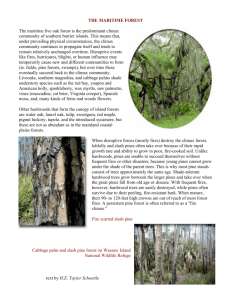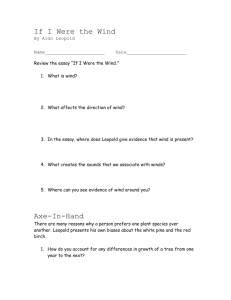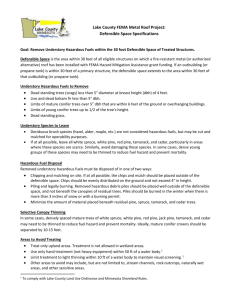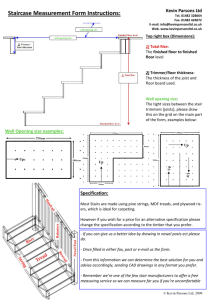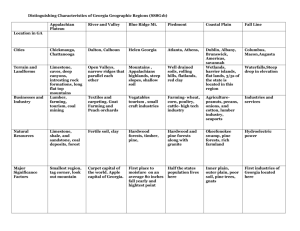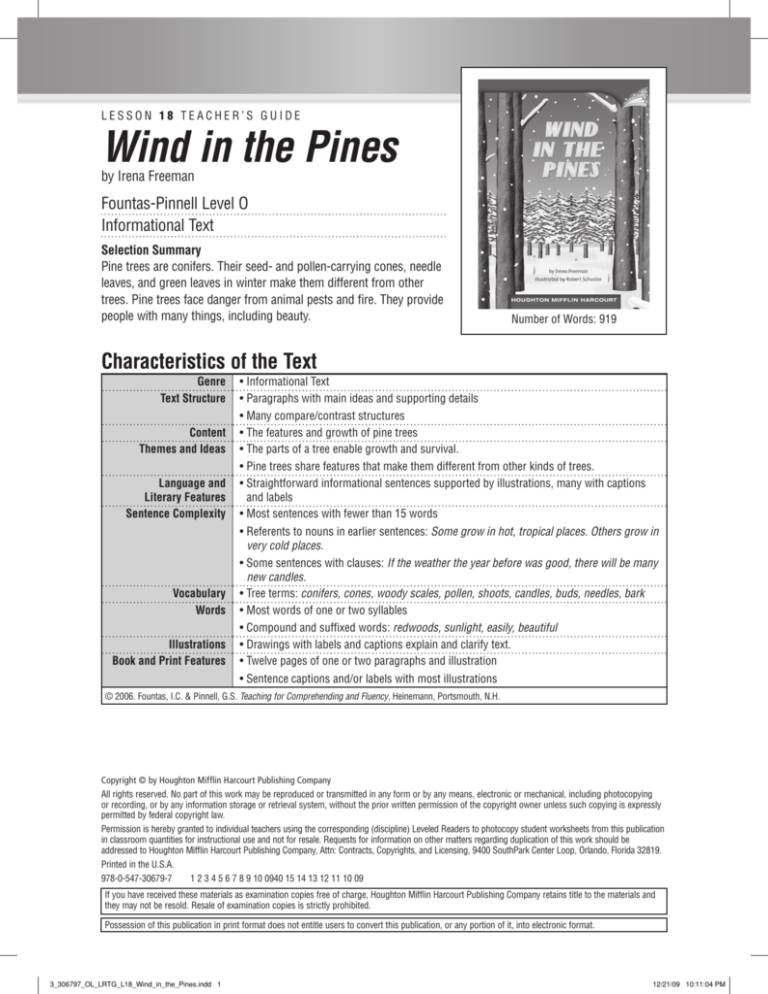
LESSON 18 TEACHER’S GUIDE
Wind in the Pines
by Irena Freeman
Fountas-Pinnell Level O
Informational Text
Selection Summary
Pine trees are conifers. Their seed- and pollen-carrying cones, needle
leaves, and green leaves in winter make them different from other
trees. Pine trees face danger from animal pests and fire. They provide
people with many things, including beauty.
Number of Words: 919
Characteristics of the Text
Genre
Text Structure
Content
Themes and Ideas
Language and
Literary Features
Sentence Complexity
Vocabulary
Words
Illustrations
Book and Print Features
• Informational Text
• Paragraphs with main ideas and supporting details
• Many compare/contrast structures
• The features and growth of pine trees
• The parts of a tree enable growth and survival.
• Pine trees share features that make them different from other kinds of trees.
• Straightforward informational sentences supported by illustrations, many with captions
and labels
• Most sentences with fewer than 15 words
• Referents to nouns in earlier sentences: Some grow in hot, tropical places. Others grow in
very cold places.
• Some sentences with clauses: If the weather the year before was good, there will be many
new candles.
• Tree terms: conifers, cones, woody scales, pollen, shoots, candles, buds, needles, bark
• Most words of one or two syllables
• Compound and suffixed words: redwoods, sunlight, easily, beautiful
• Drawings with labels and captions explain and clarify text.
• Twelve pages of one or two paragraphs and illustration
• Sentence captions and/or labels with most illustrations
© 2006. Fountas, I.C. & Pinnell, G.S. Teaching for Comprehending and Fluency, Heinemann, Portsmouth, N.H.
Copyright © by Houghton Mifflin Harcourt Publishing Company
All rights reserved. No part of this work may be reproduced or transmitted in any form or by any means, electronic or mechanical, including photocopying
or recording, or by any information storage or retrieval system, without the prior written permission of the copyright owner unless such copying is expressly
permitted by federal copyright law.
Permission is hereby granted to individual teachers using the corresponding (discipline) Leveled Readers to photocopy student worksheets from this publication
in classroom quantities for instructional use and not for resale. Requests for information on other matters regarding duplication of this work should be
addressed to Houghton Mifflin Harcourt Publishing Company, Attn: Contracts, Copyrights, and Licensing, 9400 SouthPark Center Loop, Orlando, Florida 32819.
Printed in the U.S.A.
978-0-547-30679-7
1 2 3 4 5 6 7 8 9 10 0940 15 14 13 12 11 10 09
If you have received these materials as examination copies free of charge, Houghton Mifflin Harcourt Publishing Company retains title to the materials and
they may not be resold. Resale of examination copies is strictly prohibited.
Possession of this publication in print format does not entitle users to convert this publication, or any portion of it, into electronic format.
3_306797_OL_LRTG_L18_Wind_in_the_Pines.indd 1
12/21/09 10:11:04 PM
Wind in the Pines
by Irena Freeman
Build Background
Build interest by asking questions such as the following: What kinds of trees do you see in
your town or city? Do you know what makes a pine tree different from other trees? Read
the title and author, and talk about the cover illustration. Tell students that the words and
pictures in this book give facts about pine trees.
Introduce the Text
Guide students through the text, noting important ideas and helping with unfamiliar
language and vocabulary so that they can read the text successfully. Here are some
suggestions:
Page 3: Tell students that this book gives information about pine trees.
Suggested language: Turn to page 3 of this book. The picture shows a winter
scene with pine trees. You will learn what keeps these special trees green all winter.
Page 4: Turn to page 4. Point out the word conifer, and explain that it is made from
the word cone. Why do you think the author included a picture of a man among the
different size conifers?
Page 5: Turn to page 5 and read the caption. Have you ever seen this kind of pine
cone?
Page 8: Explain that it is hard for new pine trees to grow up. Then point to the
illustration and ask: What problem is shown in the picture?
Pages 10–11: Explain that these pages tell about the leaves of pine trees, which
are called needles. All leaves, including pine needles, store sunlight and turn it into
food. Have you ever see old pine needles on the ground? They’re there because
they don’t rot and dissolve back into the ground like other leaves do.
Now turn back to the beginning of the book and read to find out about pine trees.
Target Vocabulary
absorb – soak up, p. 8
clumps – n. small groups of
things such as plants or
flowers that grow close
together, p. 11
coverings – outside layers that
protect what is underneath,
p. 7
Grade 3
dissolve – to mix completely with
a liquid, p. 11
store – v. to put away until
needed, p. 10
passages – paths, p. 14
throughout – all over the area,
p. 3
pollen – a fine powder that is
made by flowers and used to
make seeds, p. 6
tropical – hot and wet places
near the equator, p. 4
spines – long, sharp points on a
plant or animal’s body, p. 10
2
Lesson 18: Wind in the Pines
© Houghton Mifflin Harcourt Publishing Company
3_306797_OL_LRTG_L18_Wind_in_the_Pinesi.ndd 2
7/29/09 6:08:09 PM
Read
Have students read Wind in the Pines silently while you listen to individual students read.
Support their problem solving and fluency as needed.
Remind students to use the Question Strategy
questions as they read.
and to think of
Discuss and Revisit the Text
Personal Response
Invite students to share their personal responses to the book.
Suggested language: How are pine trees alike and different from other trees?
Ways of Thinking
As you discuss the text, help students understand these points:
Thinking Within the Text
Thinking Beyond the Text
Thinking About the Text
• Pine trees are conifers. Their
cones hold seeds and pollen.
• The natural world is amazingly
complex.
• The author did research to find
facts about pine trees.
• Pine trees’ leaves are called
needles. The needles do not drop
all at once, so the trees look
green year round.
• Pine trees are a part of the
natural cycle of life.
• The author’s purpose in writing
the book is to inform readers
about pine trees.
• Many things prevent new pine
trees from growing, and grown
trees face enemies.
• Fire is bad for pine trees in some
ways but good in other ways.
• The author explained information
about pine trees by showing how
pine trees are like and different
from other trees.
• People use products of pine
trees and enjoy their beauty.
© 2006. Fountas, I.C. & Pinnell, G.S. Teaching for Comprehending and Fluency, Heinemann, Portsmouth, N.H.
Choices for Further Support
• Fluency Invite students to choose a passage from the text to read aloud. Remind them
to use punctuation to help them group words.
• Comprehension Based on your observations of the students’ reading and discussion,
revisit parts of the text to clarify or extend comprehension. Remind students to go
back to the text to support their ideas.
• Phonics/Word Work Provide practice as needed with words and word parts, using
examples from the text. Explain that many words have multiple meanings. Use these
words from the book to have students contrast an everyday meaning with a scientific
meaning related to pine trees: cone, needle, candle, scales, bark, shoots.
Grade 3
3
Lesson 18: Wind in the Pines
© Houghton Mifflin Harcourt Publishing Company
3_306797_OL_LRTG_L18_Wind_in_the_Pines.indd 3
11/2/09 10:29:39 PM
Writing about Reading
Critical Thinking
Have students complete the Critical Thinking questions on BLM 18.8.
Responding
Have students complete the activities at the back of the book. Use the instruction below as
needed to reinforce or extend understanding of the comprehension skill.
Target Comprehension Skill
Text and Graphic Features
Tell students that when they use text and
graphic features, they can get information from the words and the pictures. Model the
skill, using a “Think Aloud” like the one below:
Think Aloud
The illustrations in this book have information to help readers learn about
pine trees. Some pictures have captions. They are sentences that tell
what is shown, like the sentence captions on page 7. Some pictures, like
the ones on page 6, have labels. The labels help support what the words
say. On page 10, the pictures of different kinds of leaves help readers
understand the main idea in the paragraph: that all leaves do the same
job, but pine leaves look different from flat leaves.
Practice the Skill
Have students tell what the illustrations on pages 4, 9, and 11 show, and why each is in
the book.
Writing Prompt: Thinking Beyond the Text
Have students write a response to the prompt on page 6. Remind them that when they
think beyond the text, they use their personal knowledge to reach new understandings.
Assessment Prompts
• On page 9, find the word that means “new shoots.”
• Find the details on page 12 that tell about the enemies of pine trees.
• Complete this sentence in your own words: The author probably wrote this text to
________________________________________________________________.
Grade 3
4
Lesson 18: Wind in the Pines
© Houghton Mifflin Harcourt Publishing Company
3_306797_OL_LRTG_L18_Wind_in_the_Pines.indd 4
12/21/09 10:28:38 PM
English Language Development
Reading Support Give English learners a “preview” of the text by holding a brief
small-group discussion with them before reading the text with the entire group.
Cognates Point out that the word pine in English is like the word pino in Spanish.
Use the illustrations to help students understand why the tree parts are called candles
(candelas) and cones (conos).
Oral Language Development
Check student comprehension, using a dialogue that best matches your students’
English proficiency level. Speaker 1 is the teacher, Speaker 2 is the student.
Beginning/Early Intermediate
Intermediate
Early Advanced/Advanced
Speaker 1: What is this book about?
Speaker 1: How can you tell that a tree
is a pine?
Speaker 1: How are pine trees
different from other kinds of
trees?
Speaker 2: pine trees
Speaker 1: What are needles?
Speaker 2: pine tree leaves
Speaker 1: Where are the seeds in a
pine tree?
Speaker 2: inside the cones
Speaker 2: It has needles and cones.
Speaker 1: Describe the part of a pine
tree that holds the seeds for a new tree.
Speaker 2: The hard cone has woody
scales, and the seeds are between the
scales.
Speaker 2: They are conifers.
They have two kinds of cones
that hold seeds and pollen. Their
leaves are long and thin and are
called needles. They stay green
even in northern winters.
3_246239RTXEAN_L16-20CT.indd Page Sec2:10 3/7/09 12:04:36 AM user-043
/Volumes/118/HS00117/work%0/indd%0/Critical_Thinking/3_246239RTXEAN_U04L16-20CT
Lesson 18
Name
Date
BLACKLINE MASTER 18.8
Critical Thinking
Wind in the Pines
Critical Thinking
Read and answer the questions.
1. Think within the text What do all pine trees have in
common?
All pine trees have cones.
2. Think within the text What are some different types of
conifers?
Possible response: Eastern white pine, redwood, and Scotch pine
3. Think beyond the text Pine trees have hard and soft
cones. Why do these trees need both types of cones?
Possible response: The soft cones make pollen, which is needed to start new
seeds. The hard cones use the pollen to make the seeds.
4. Think about the text Look at the picture on page 7. It
shows what a forest looks like after a fire. Explain why
pine trees are among the first plants to grow back.
Possible response: Heat from the fire can cause the hard cones to open up. When
this happens, the seeds inside will fall to the ground and start growing.
Making Connections Many useful products come from pine trees.
Look around your home or neighborhood and see if you can spot
things that are made from pine trees. What did you find?
Write your answer in your Reader’s Notebook.
Read directions to students.
Critical Thinking
10
Grade 3, Unit 4: Extreme Nature
© Houghton Mifflin Harcourt Publishing Company. All rights reserved.
Grade 3
5
Lesson 18: Wind in the Pines
© Houghton Mifflin Harcourt Publishing Company
3_306797_OL_LRTG_L18_Wind_in_the_Pinesi.ndd 5
7/29/09 6:08:11 PM
Name
Date
Wind in the Pines
Thinking Beyond the Text
Read the following paragraph. Then write your response below.
Imagine that your town or city wants to tear down a forest of pine trees to
build a mall there. Write a letter to the newspaper. Explain why the pine trees
should be saved. Use details from the book in your letter.
Grade 3
6
Lesson 18: Wind in the Pines
© Houghton Mifflin Harcourt Publishing Company
3_306797_OL_LRTG_L18_Wind_in_the_Pinesi.ndd 6
7/29/09 6:08:12 PM
Lesson 18
Name
Date
BLACKLINE MASTER 18.8
Critical Thinking
Wind in the Pines
Critical Thinking
Read and answer the questions.
1. Think within the text What do all pine trees have in
common?
2. Think within the text What are some different types of
conifers?
3. Think beyond the text Pine trees have hard and soft
cones. Why do these trees need both types of cones?
4. Think about the text Look at the picture on page 7.
It shows what a forest looks like after a fire. Explain why
pine trees are among the first plants to grow back.
Making Connections Many useful products come from pine trees.
Look around your home or neighborhood and see if you can spot
things that are made from pine trees. What did you find?
Write your answer in your Reader’s Notebook.
Grade 3
7
Lesson 18: Wind in the Pines
© Houghton Mifflin Harcourt Publishing Company
3_306797_OL_LRTG_L18_Wind_in_the_Pinesi.ndd 7
7/29/09 6:08:13 PM
Student
Lesson 18
Date
BLACKLINE MASTER 18.12
Wind in the Pines • LEVEL O
page
9
Wind in the Pines
Running Record Form
Selection Text
Errors
Self-Corrections
Accuracy Rate
Total SelfCorrections
Each spring, pines send up shoots. These shoots are called
candles. If the weather the year before was good, there will be
many new candles. If the weather was too cold or too dry,
there will not be as many candles.
10
New pine branches and their needles grow from the buds at
the end of the candles. Needles may not seem like leaves, but
they are very thin leaves that look like green spines.
Comments:
(# words read
correctly/74 × 100)
%
Read word correctly
Code
✓
cat
Repeated word,
sentence, or phrase
®
Omission
—
cat
cat
Grade 3
Behavior
Error
0
0
1
8
Substitution
Code
cut
cat
1
Self-corrects
cut sc
cat
0
Insertion
the
1
Word told
T
cat
cat
Error
1414072
Behavior
1
Lesson 18: Wind in the Pines
© Houghton Mifflin Harcourt Publishing Company
3_306797_OL_LRTG_L18_Wind_in_the_Pines.indd 8
12/9/09 9:07:14 PM


